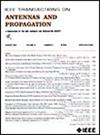基于周期特性模式分析的小型低轮廓线性天线阵列带内散射抑制
IF 5.8
1区 计算机科学
Q1 ENGINEERING, ELECTRICAL & ELECTRONIC
引用次数: 0
摘要
本文提出了一种用于小型低轮廓线性天线阵列的散射抑制技术。以x波段(8.0-12.0 GHz)天线阵列为例,采用周期特征模式分析(PCMA)揭示了散射机理。研究发现,8.0 GHz处的散射主要来自于地平面中心,而12.0 GHz处的散射主要来自于地平面边缘。为了减少8.0 GHz的散射,在辐射孔径上集成了数字间贴片,以产生反向电流,抵消地平面上的散射电流。此外,引入带短脚的寄生贴片将水平电流转换为垂直电流,进一步抑制了12.0 GHz的散射。这种抑制技术适用于横向尺寸较小的线性天线阵。它不增加轮廓高度,可以提高阵列的增益。通过$2\ × 8$有限数组验证了该技术的有效性。天线阵列工作在8.0 - 12.0 ghz范围内,扫描范围为±45°。此外,与参考阵列相比,带内单基地雷达截面(RCS)降低了至少10 dB。本文章由计算机程序翻译,如有差异,请以英文原文为准。
In-Band Scattering Suppression for Compact and Low-Profile Linear Antenna Arrays Using Periodic Characteristic Mode Analysis
This article presents a scattering suppression technique for compact and low-profile linear antenna arrays. Periodic characteristic mode analysis (PCMA) is implemented to reveal the scattering mechanisms, using an X-band (8.0–12.0 GHz) antenna array as an illustration. It is found that the scattering at 8.0 GHz primarily comes from the center of the ground plane, while the scattering at 12.0 GHz is dominated by the edges of the ground plane. To reduce the scattering at 8.0 GHz, interdigital patches are integrated over the radiation aperture to create a reverse current that counteracts the scattering current on the ground plane. In addition, parasitic patches with shorting pins are introduced to convert the horizontal current into the vertical current, further suppressing the scattering at 12.0 GHz. The suppression technique is applicable for linear antenna arrays with small transverse dimensions. It does not increase the profile height and can enhance the gain of the array. The effectiveness of this technique is validated through a $2\times 8$ finite array. The antenna array operates in the 8.0–12.0-GHz range with a scanning range of ±45°. Moreover, the in-band monostatic radar cross section (RCS) is reduced by at least 10 dB compared to the reference array.
求助全文
通过发布文献求助,成功后即可免费获取论文全文。
去求助
来源期刊
CiteScore
10.40
自引率
28.10%
发文量
968
审稿时长
4.7 months
期刊介绍:
IEEE Transactions on Antennas and Propagation includes theoretical and experimental advances in antennas, including design and development, and in the propagation of electromagnetic waves, including scattering, diffraction, and interaction with continuous media; and applications pertaining to antennas and propagation, such as remote sensing, applied optics, and millimeter and submillimeter wave techniques

 求助内容:
求助内容: 应助结果提醒方式:
应助结果提醒方式:


